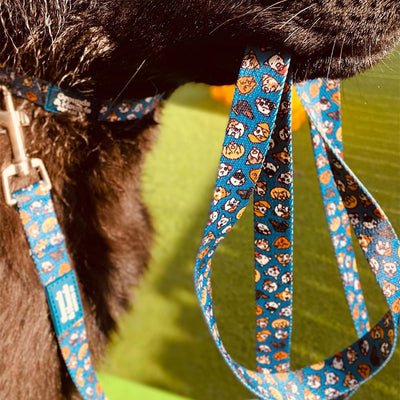Barking is a natural and often necessary form of communication for dogs. It's how they typically express excitement, alert their owners to potential threats, and even seek companionship from other animals.
However, when your dog barks at every stranger who crosses their path, what should be normal behavior can quickly become a nuisance or even a scary experience to the people you come by. Constant barking at every unfamiliar person or pet that you come across will also make everyday activities with your dog, like walks at the park, less enjoyable for the both of you.
If you want to effectively manage this behavior, you need to understand why it happens in the first place—and how, as a responsible pet owner, you can help your canine companion become more at ease around new faces. Here’s PrideBites’ guide to addressing the problem, as well as how to use dog equipment like custom dog leashes to gently, but firmly rein your dog in.
Why Exactly Do Dogs Bark at Strangers?
Several things can account for your dog’s habit of barking at strangers, including the following:
1) Territorial Behavior
Dogs have a natural protective instinct, and they may bark at strangers to alert their owners or deter potential intruders from entering their territory. Barking, in this case, manifests as a way for them to safeguard their home turf and family.
2) Fear and Anxiety
Some dogs bark at strangers due to fear or anxiety. It’s a possibility that they perceive unfamiliar people as a threat and thus respond with barking as a way to cope with their discomfort.
3) Social Interaction
Most dogs are social animals, and barking can be their means of initiating social interaction. If your dog is excited to meet new people, they may express their enthusiasm through barking as a way to engage and connect.
4) Guarding Instinct
Certain breeds, such as guard or herding dogs, have a strong guarding instinct. They may bark at strangers as part of their natural instincts to protect their home or flock.
5) Lack of Socialization
It’s also a factor if a dog hasn’t been adequately socialized with a variety of people and situations as a puppy. That may make them more likely to bark at strangers because they are not accustomed to new experiences.
6) Attention-Seeking
In some cases, dogs may also bark at strangers to get attention from their owners. If the barking results in getting your attention and a certain kind of response from you, like a pat, the dog may learn to use this behavior to get what they want.
How to Train Your Dog to Bark Less at Strangers
Whatever the scenario, excessive barking at strangers can be impolite at best and scary to other people and animals at first. It may also be indicative of a deeper problem that you and your dog should address through careful training.
Below are some steps you can follow to reduce your dog’s barking and to help them be more at ease around strangers in general:
1) Take Opportunities to Socialize Them
Socializing your dog early on–that is, exposing your dog to different people, environments, and situations from an early age–can prevent them from making a habit of barking excessively at strangers. Make these experiences positive by offering treats, praise, and playtime during interactions with new people. Gradual and positive exposure to other people and animals will eventually help your dog become more comfortable with strangers.
2) Practice Basic Obedience Training with Them
Basic obedience training is a fundamental tool for managing your dog's behavior around strangers. Commands like "sit," "stay," and "leave it” can be used to redirect your dog's attention and control their behavior whenever they encounter an unfamiliar face. Practice these commands during your socialization efforts, too, to reinforce your dog’s good behavior.
3) Gradually Desensitize Your Dog to the Idea of Strangers
Desensitization refers to the process of gradually reducing your pet’s response to a trigger, and you can use it to make them less reactive to strangers. Start with low-stress situations and gradually expose your dog to strangers in controlled settings, and again, use treats and rewards to reinforce positive behavior. Over time, your dog will learn that meeting new people is not a bad thing or something they should dread.
4) Try Counterconditioning Techniques
It’s also possible to change your dog's emotional response to strangers through counterconditioning or response substitution. Whenever your dog remains calm or friendly around strangers, reward them with treats or praise. If your dog barks for your attention in the presence of other people, heap attention on them when they’re being quiet instead. This will help your dog associate strangers with positive experiences, gradually reducing their urge to bark.
5) Practice Patience and Consistency
It takes time to change your dog’s behavior, so practice patience and consistency in all of your training efforts. Avoid scolding or punishing your dog for barking, as this can exacerbate their anxiety or aggression towards strangers. Instead, focus on rewarding and reinforcing calm and friendly behavior.
6) Seek Professional Help If You Need To
If you find it challenging to manage your dog's behavior on your own, consider consulting a professional dog trainer or behaviorist. They might be able to give you some perspective about your dog’s behavior that you haven’t yet considered. In addition, you can turn to them to help you create a customized training plan around fixing the issue.
If you can help your dog become more relaxed and open to strangers, your interactions with new people and animals will be much more enjoyable for both you and your canine. With dedication, you'll not only reduce the unwanted barking, but also manage your dog’s stress levels better and make them more inclined to look forward to excursions outside your home.








